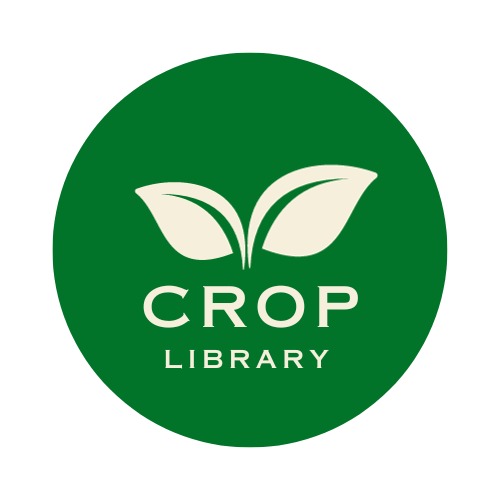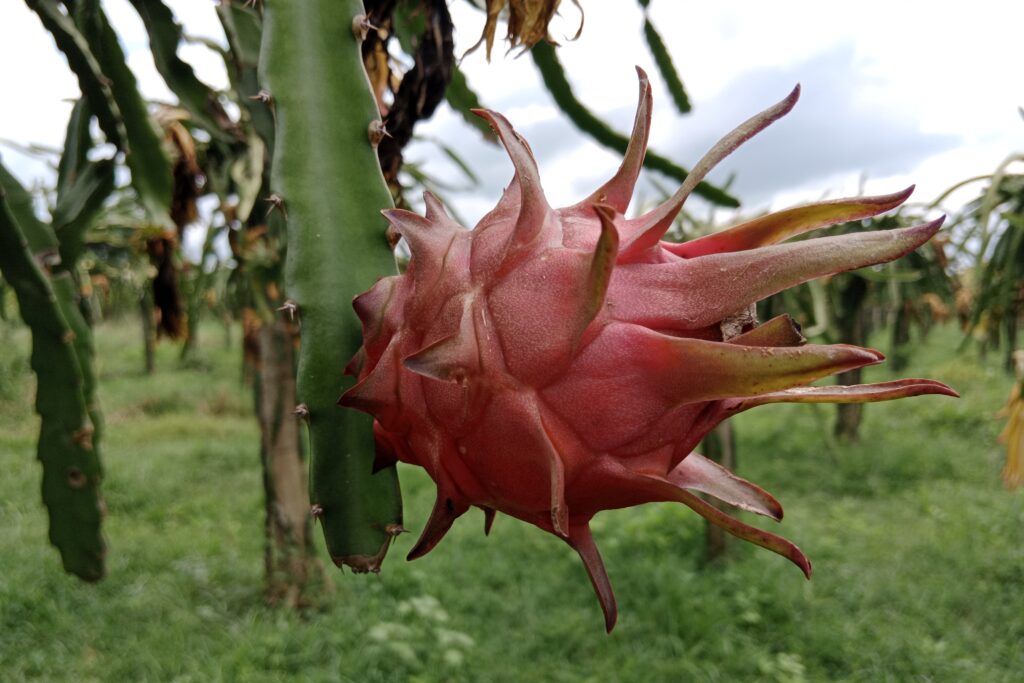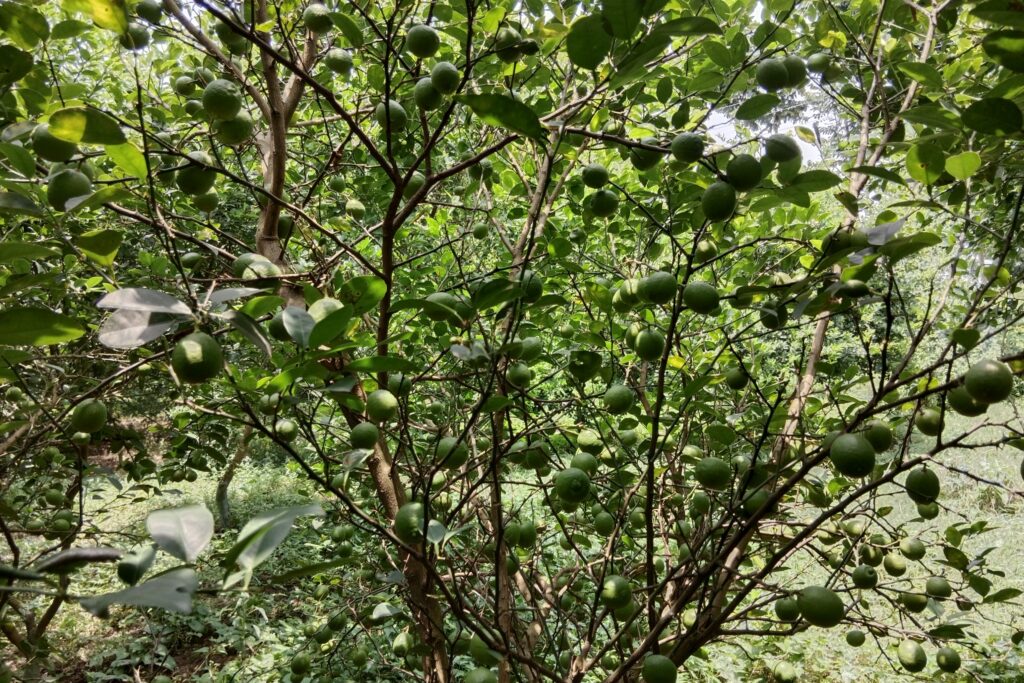Chekurmanis Farming
Chekurmanis (Sauropus androgynus), also known as the Sweet Leaf Bush or Star Gooseberry, is a tropical leafy shrub valued for both its flavor and nutritional content. The tender leaves have a naturally sweet taste and are an excellent source of essential vitamins, minerals, and antioxidants. This hardy plant requires minimal care and offers good potential for small-scale or commercial cultivation due to its consistent yield and low maintenance needs.
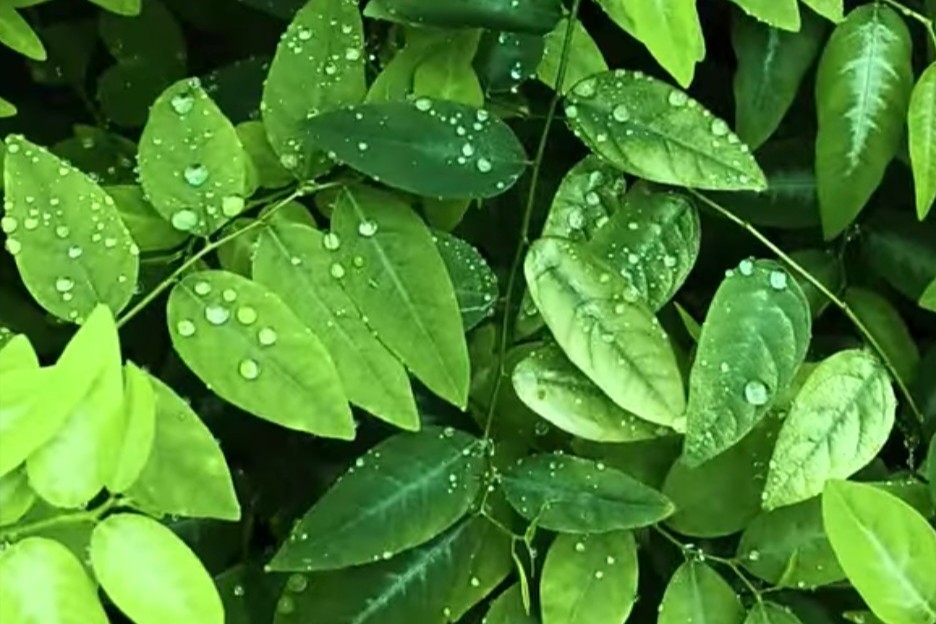
Chekurmanis farming requires a significant initial investment, but it becomes financially rewarding over time. The venture reaches its break-even point and begins generating a positive cumulative cash flow by the third year.
From this stage onward, Chekurmanis farming profit per acre increases substantially as yields improve, making the enterprise highly profitable in the fourth and fifth years, with annual profits of around NRs. 130,000. Overall, it offers an excellent long-term return, achieving a total net profit of approximately NRs. 302,000 over five years, proving its strong viability for farmers who can manage the initial investment and early years of lower returns.
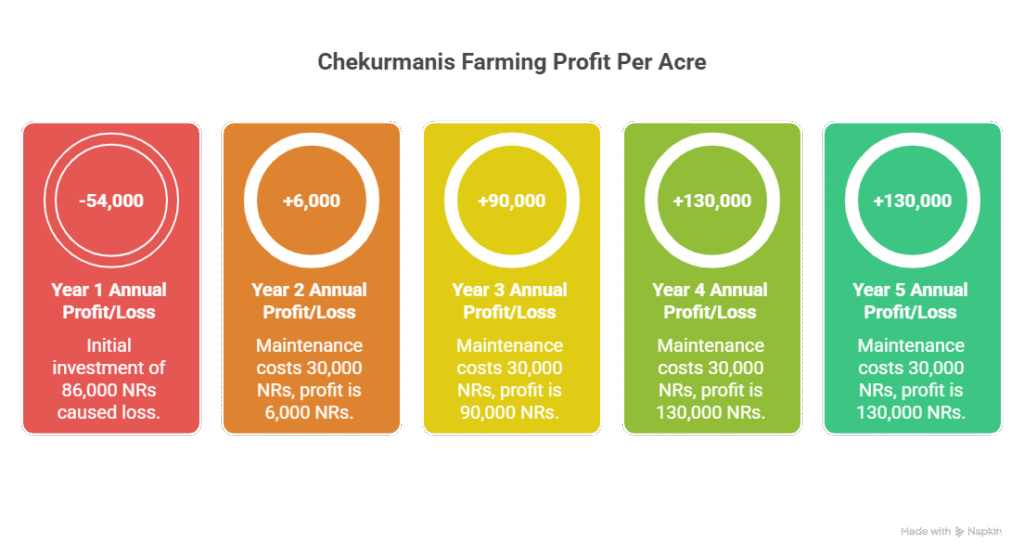
Land Preparation
Preparing land for cultivation requires thorough tillage to create a fine, loose soil structure suitable for seed germination and root growth. Typically, the process begins with a deep ploughing, followed by two or three passes with a harrow or rotavator to achieve the desired soil texture. All unwanted materials such as weeds, stones, and remnants of previous crops should be cleared to maintain a clean seedbed.
During the final stage of preparation, incorporate well-decomposed compost or farmyard manure (FYM) into the soil to enhance its fertility and overall structure. In low-lying or poorly drained areas, forming raised beds is recommended to prevent water stagnation and support healthy root development.
Soil Type
Chekurmanis can adapt to a variety of soil types; however, it thrives best in well-drained sandy loam or loam soils rich in organic content. For optimal growth, the soil should have a slightly acidic to neutral reaction, with a pH between 5.5 and 6.5. Heavy clay soils are generally unsuitable unless amended with ample organic matter to improve both aeration and drainage.
Climatic Requirements
Chekurmanis is a tropical species that flourishes in warm and humid environments, ideally where temperatures range from 22°C to 30°C. The plant is very sensitive to frost and extended periods of low temperature, which can hinder its growth.
It performs best in areas with high humidity and consistent rainfall but cannot tolerate waterlogged conditions. Although it grows well under both full sunlight and partial shade, plants cultivated in partial shade generally produce softer, more tender leaves, making this environment slightly more suitable for high-quality leaf production.
Major Cultivars
Chekurmanis does not have officially recognized or standardized cultivars as seen in major commercial crops. However, noticeable variations occur among plants in terms of leaf size, stem color, and overall growth pattern. Farmers typically select and propagate plants from local landraces that show good performance under their regional conditions. Some varieties display green stems, while others exhibit a reddish hue.
Propagation
Chekurmanis is most effectively multiplied through stem cuttings, as this technique promotes faster growth and preserves the genetic characteristics of the parent plant better than seed propagation. For optimal results, cuttings should be obtained from healthy, disease-free mother plants that show strong growth.
Semi-mature shoots from the previous season generally root best. Each cutting, about 15–20 cm long and containing three to four nodes, provides good potential for root development and establishment. Treating the cut ends with a light concentration of auxins—such as 50 ppm IAA or IBA—before placing them in polybags can further encourage rooting, which typically becomes visible within three to four weeks.
Seedling Rate per Acre
In Chekurmanis cultivation, stem cuttings serve as the main planting material, with about 11,250 cuttings needed to adequately plant one acre of land.
Nursery Management
For successful propagation of Chekurmanis, prepare slightly raised nursery beds in an area that receives filtered sunlight or partial shade. Use a well-balanced mixture of fine soil, sand, and decomposed organic matter to ensure good drainage and aeration.
Before planting, dip the lower ends of stem cuttings in a rooting stimulant to encourage quicker root initiation. Insert the cuttings so that two or three nodes remain below the surface of the soil.
Keep the beds evenly moist without allowing water to stagnate. Root formation generally begins within two to three weeks, and after about four to five weeks—once the cuttings have produced healthy roots and new shoots—they can be transplanted into the main field.
Planting
a). Planting Season
The best time for planting is at the onset of the rainy season to ensure proper establishment; however, in tropical regions with available irrigation, planting can be done throughout the year.
b). Planting Direction
Rows should be oriented to maximize sunlight exposure, typically in a North-South direction.
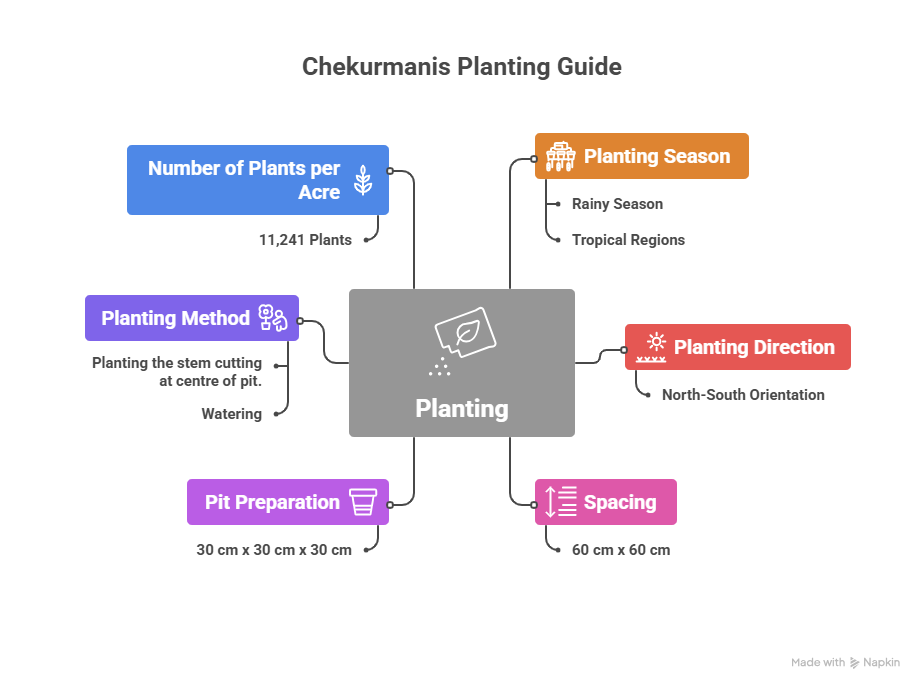
c). Spacing
A spacing arrangement of 60 cm x 60cm between rows and individual plants is generally advised, as this distance promotes sufficient airflow around the plants and makes harvesting operations more convenient.
d). Pit Preparation
Dig pits of approximately 30 cm x 30 cm x 30 cm.
e). Planting Method
Fill the pits with a mixture of topsoil and 2-3 kg of well-rotted FYM or compost. Place the rooted cutting or seedling in the center of the pit, fill with soil, and firm it gently around the base. Water immediately after transplanting.
f). Number of Plants per Acre
At a spacing of 60 cm x 60 cm, the total number of plants per acre is approximately 11,241 plants.
Intercropping
Chekurmanis grows well in intercropping systems, especially within young orchards of crops like coconut, mango, or durian, because it can thrive under partial shade. It may also be cultivated with taller vegetable species during its early growth phase, allowing for more efficient land utilization and the opportunity to earn supplementary income.
Irrigation
Chekurmanis thrives best under consistently moist conditions to ensure continuous production of tender leaves. Drip irrigation is particularly advisable, as it helps conserve water while keeping the foliage dry, thereby lowering the risk of disease.
Watering should be done immediately after transplanting and then at intervals of about every three to four days during dry periods. In the rainy season, irrigation is only necessary when required to maintain moist—but not waterlogged—soil conditions.
Fertilizer and Manure
Chekurmanis shows excellent growth when supplied with organic nutrients. During pit preparation, it is advisable to incorporate about 10–15 tonnes of farmyard manure (FYM) or compost per acre as a basal application, along with a balanced fertilizer such as NPK 15:15:15 at a rate of approximately 200–250 kg per acre.
Following each major harvest, a top dressing using nitrogen-enriched fertilizer—such as urea—or an additional layer of compost helps stimulate new shoot development. Applying foliar sprays that contain essential micronutrients can also improve overall plant vigor and boost yield.
Weed Control
Effective weed management is crucial during the early growth phase of Chekurmanis. Weeds can be controlled manually using a hoe or by spreading an organic mulch—such as straw, dried leaves, or other plant residues—around the base of the plants. This practice not only suppresses weed emergence but also helps retain soil moisture and gradually enriches the soil with organic matter as the mulch decomposes.
Interculture Operation
Training
Young Chekurmanis plants may be supported with stakes to encourage upright growth and to minimize the risk of lodging or bending under their own weight.
Pruning
Pruning plays an important role in sustaining vigorous and high-yielding plants. Routine harvesting naturally acts as a light pruning process. To promote a compact, bushy structure with more lateral branches, the growing tips should be pinched off once the plants reach a height of about 30–45 cm (approximately 1–1.5 feet). As plants mature, older stems often lose productivity and can be cut back to ground level to stimulate the emergence of fresh, healthy shoots from the base.
Flowering and Fruit Management
Chekurmanis develops small red flowers; however, flowering is not desirable when the goal is to maximize leaf yield, as it diverts energy from vegetative growth.
To maintain a consistent supply of tender leaves, plants should be inspected frequently, and any flower buds that emerge should be promptly removed. This practice helps redirect the plant’s resources toward foliage development, ensuring sustained productivity and quality.
Pest and Disease Management
Chekurmanis is generally hardy but can be affected by some pests and diseases.
Common Pests
Caterpillars and Leaf Miners
The leaves of the Chekurmanis plant are often consumed by caterpillars and leaf miners. These pests damage the foliage by eating holes and boring tunnels, which diminishes the plant’s health and the quality of its leaves. A successful biological control method is the application of Bacillus thuringiensis (Bt), mixed at a rate of 2–3 grams per liter of water.
Alternatively, neem oil insecticides can be used at a concentration of 5–10 ml per liter. These solutions should be sprayed directly onto the infested leaves. To prevent extensive damage, it is crucial to inspect plants regularly for early signs of these insects.
Aphids and Mealybugs
Sap-sucking pests like aphids and mealybugs can cause leaves to curl, yellow, and stunt the plant’s growth. To manage these infestations, a simple 2% soapy water solution can be sprayed onto the foliage. For more persistent problems, an insecticide such as imidacloprid, applied at 0.5–1 ml per liter of water, is effective. To protect helpful insects, these sprays are best administered during the early morning or late evening.
Snails and Slugs
The tender new growth of the plant is particularly vulnerable to snails and slugs, especially in damp weather, and their feeding can lead to substantial leaf loss. Control strategies include manually removing them, setting up physical barriers, or using bait that contains metaldehyde at 1–2 grams per square meter. Good field hygiene, such as keeping the area free of debris and moisture, can also discourage these pests and help prevent future outbreaks.
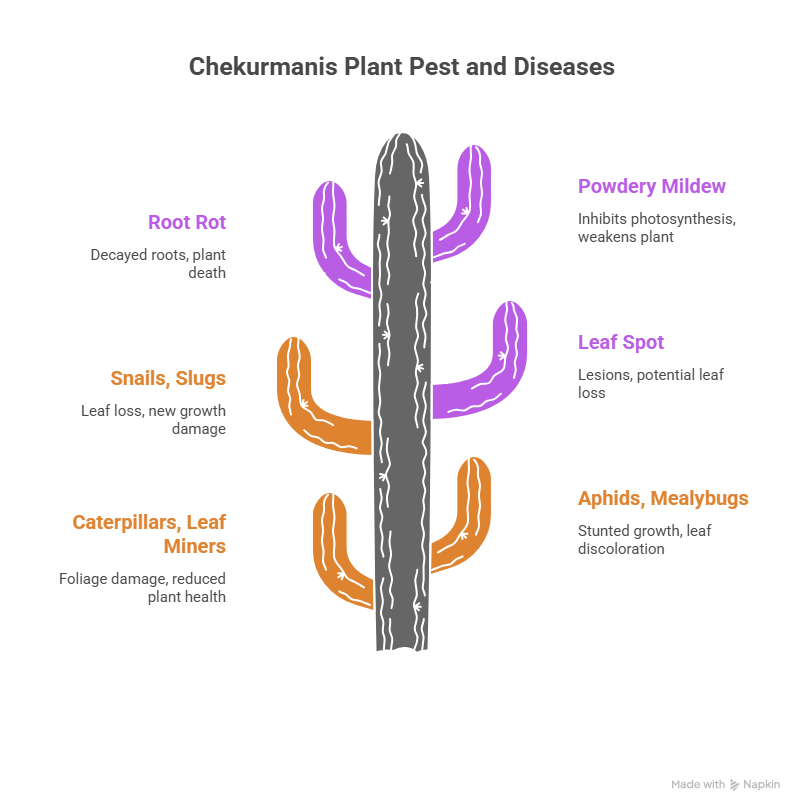
Common Diseases
Leaf Spot
Chekurmanis plants can be affected by leaf spot, a fungal disease identified by small, dark brown or black lesions on the foliage. These spots may enlarge and merge, potentially causing significant leaf loss in advanced cases.
Management involves promoting better air flow through adequate plant spacing and selective pruning. For serious infections, a fungicide should be applied, such as copper oxychloride (2g/L of water) or mancozeb (2-3g/L). Affected leaves need a thorough spray every 10 to 15 days until the condition improves.
Root Rot
This condition, often a result of waterlogged soil and insufficient drainage, causes the roots to become soft, dark, and decayed, ultimately leading the plant to wilt and die. Prevention is the most effective strategy, focusing on ensuring good drainage, careful watering to avoid saturation, and removing any severely infected plants from the area. Since fungicides are typically ineffective against advanced root rot, emphasis should be placed on these cultural practices and enhancing overall soil quality.
Powdery Mildew
A clear sign of this fungal issue is a white, powdery coating on the plant’s leaves, stems, and buds. This coating inhibits photosynthesis, weakening the plant. Control measures include foliar sprays of sulfur-based fungicides (1-2g/L of water) or potassium bicarbonate (2-3g/L), applied at 7-10 day intervals during an active outbreak. Additionally, ensuring good ventilation and refraining from overhead watering can help prevent its development.
Harvesting
Harvesting Chekurmanis can begin 2–3 months after planting, focusing on young, tender shoots and leaves. The top 10–15 cm of the stem, including 4–6 leaves, is typically harvested by hand-picking or using a sharp knife or scissors. With proper management, harvesting can be carried out every 2–3 weeks to ensure continuous supply of fresh leaves.
Yield
The yield of Chekurmanis depends on crop management, soil fertility, and harvesting frequency, with a well-maintained plantation producing 4,000 to 6,000 kg of fresh leaves per acre per year, and potentially higher yields under excellent management. As a perennial plant, Chekurmanis can remain productive for 2–3 years before replanting is necessary.
Cost of Investment per Acre for Chekurmanis Farming
| S.N. | Categories | Cost of Investment (NRs.) |
| 1 | Land Preparation | 15,000 |
| 2 | Planting Materials (Stem Cuttings) | 30,000 |
| 3 | Planting | 8,000 |
| 4 | Fertilizers and Manure | 10,000 |
| 5 | Irrigation | 8,000 |
| 6 | Weed Control (Pre & Post-emergence) | 2,000 |
| 7 | Pest & Disease Control | 4,000 |
| 8 | Harvesting | 4,000 |
| 9 | Miscellaneous Costs | 5,000 |
| Total Initial Investment | 86,000 |
Annual Maintenance Cost
The annual maintenance cost for Chekurmanis farming is approximately NRs. 30,000 per acre, which covers essential activities such as fertilizer application, irrigation, pest and weed control, and labor required for routine field management and upkeep.
Income per acre from Chekurmanis farming
| Year | Estimated Yield (Kg) | Market Price (NRs./Kg) | Total Income (NRs.) |
| 1st Year | 800 | 40 | 32,000 |
| 2nd Year | 900 | 40 | 36,000 |
| 3rd Year | 3,000 | 40 | 120,000 |
| 4th-5th Year | 4,000 | 40 | 160,000 |
Analysis of Chekurmanis Farming Profit Per Acre
| Year | Income (NRs.) | Costs (NRs.) | Annual Profit/Loss (NRs.) | Cumulative Cash Flow (NRs.) |
| 1 | 32,000 | 86,000 (Initial Investment) | -54,000 (Loss) | -54,000 |
| 2 | 36,000 | 30,000 (Maintenance) | +6,000 (Profit) | -48,000 |
| 3 | 120,000 | 30,000 (Maintenance) | +90,000 (Profit) | +42,000 |
| 4 | 160,000 | 30,000 (Maintenance) | +130,000 (Profit) | +172,000 |
| 5 | 160,000 | 30,000 (Maintenance) | +130,000 (Profit) | +302,000 |
Chekurmanis farming requires a significant initial investment, resulting in a substantial first-year loss of approximately NRs. 54,000 due to high establishment costs and low yield as the plant focuses on development. However, the venture reaches its break-even point and begins generating a positive cumulative cash flow by the third year.
From this point onward, profitability increases substantially with the growing yield, making the farm highly profitable in the fourth and fifth years with annual profits reaching around NRs. 130,000.
Ultimately, this demonstrates an excellent long-term return, with a total net profit of about NRs. 302,000 over five years, affirming its viability for farmers who can manage the upfront costs and initial period of low returns.
Sources
Food and Agriculture Organization (FAO)
University of California Agriculture & Natural Resources (UC ANR)
European Plant Protection Organization (EPPO)
Punjab Agricultural University (PAU)
Tamil Nadu Agriculture University (TNAU) – Agritech portal
Indian Council of Agricultural Research (ICAR)
Nepal Agricultural Research Council (NARC)
U.S. Department of Agriculture (USDA).
Ministry of Agriculture and Livestock Development (Nepal)
Disclaimer: This crop farming profits assume optimal conditions. Actual results may vary depending on climate, market prices, and farm management practices.
